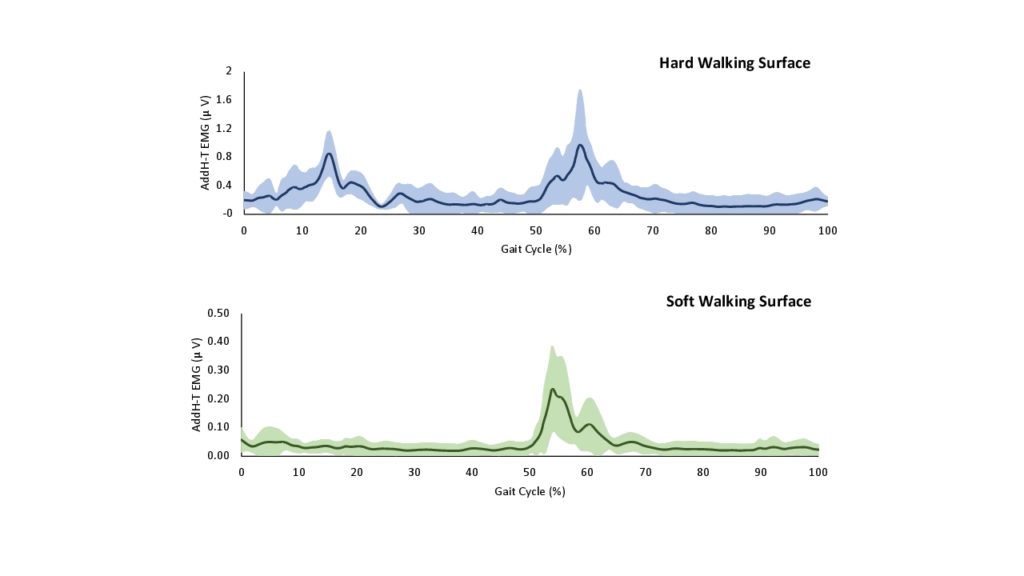By Kelly Robb
Plantar intrinsic foot muscles are commonly described as acting as one ‘functional unit’. However, previous human studies of EMG recordings of abductor hallucis and flexor digitorum brevis during walking have revealed that these muscles have unique onset/offset patterns during the gait cycle. This suggests that they may function more independently than once thought. To our knowledge, there has been no report of EMG recording of the transverse head of adductor hallucis, another plantar intrinsic foot muscle, during walking. In this study, we therefore aimed to 1) develop a fine-wire EMG technique to record EMG of the transverse head of adductor hallucis during gait, and 2) examine this muscle’s functional role during walking.
We recorded bipolar fine-wire EMG of the transverse head of adductor hallucis in 19 feet of 10 young adults during walking. Under ultrasound guidance, we inserted fine-wire electrodes into the transverse head of adductor hallucis muscle via a dorsal forefoot insertional approach. Participants then completed a series of level walking trials over a custom-made walking platform, designed to allow for manipulation of the flooring surface compliance between hard and soft foam. This flooring compliance change modified the muscular demands of the transverse head of adductor hallucis during the stance phase of the gait cycle. We compared and reported the ensemble averages between both flooring surfaces and typical phasic EMG activity of the transverse head of adductor hallucis during level walking.
We found that the transverse head of adductor hallucis appears to contract, neutralizing the role of the tibialis anterior, and acting as a forefoot stabilizer during the propulsive phase of gait. Even more intriguing, the demands of this muscle appear to change when varying the flooring compliance (Figure). These preliminary insights into the functional role of the transverse head of adductor hallucis during walking may prove informative to clinicians treating common forefoot pathologies, including hallux valgus and metatarsalgia symptoms. These results may also be useful for the design of foot orthoses and/or footwear to alleviate the muscular demands of the transverse head of adductor hallucis during walking. Future researchers are encouraged to adopt this fine-wire technique and advance transverse head of adductor hallucis EMG literature across different foot shapes and participants experiencing pathological forefoot deformities.

Figure: Representative data of the EMG bursting pattern of the transverse head of adductor hallucis during walking. When walking on a hard surface (top), peak activity occurs at approximately 15% and 60% of the gait cycle, corresponding to initial contact and propulsion phases of gait. When walking on the softer foam (bottom), there is an absence of EMG activity at initial contact, with the retention of similar bursts in EMG at propulsion.
Publication
Robb, Kelly A., Melady, Hope D. & Perry, Stephen D. (2021) Fine-wire electromyography of the transverse head of adductor hallucis during locomotion. Gait & Posture, 85, 7-13. https://doi.org/10.1016/j.gaitpost.2020.12.020
About the Author

Kelly Robb
Wilfrid Laurier University
Kelly Robb is a 4th year PhD student at Wilfrid Laurier University working alongside Dr. Stephen Perry. Kelly studies the effect of foot orthotics and texture, as a method of facilitating cutaneous mechanoreceptor activation under the plantar foot sole, on lower leg and foot intrinsic muscle activity during locomotion.
Copyright
© 2021 by the author. Except as otherwise noted, the ISPGR blog, including its text and figures, is licensed under a Creative Commons Attribution-ShareAlike 4.0 International License. To view a copy of this license, visit https://creativecommons.org/licenses/by-sa/4.0/legalcode.
ISPGR blog (ISSN 2561-4703)
Are you interested in writing a blog post for the ISPGR website? If so, please email the ISGPR Secretariat with the following information:
- First and Last Name
- Institution/Affiliation
- Paper you will be referencing


